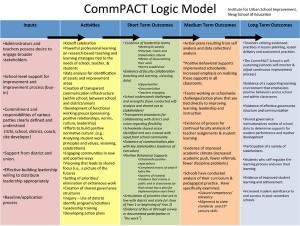Overview
This approach involves taking existing neighborhood schools and converting them to CommPACT Schools. Unlike some other alternative school models, CommPACT Schools are built on the collaborative efforts of those most directly involved with education:
- Community
- Parents
- Administrators
- Children
- Teachers
With access to the expertise of national school-improvement organizations, higher education leaders, and researchers, CommPACT Schools offer assistance in selecting and implementing evidence-based practices in governance, instruction, decision making, community involvement, and behavior management. Armed with the ability to effect positive change in these areas, CommPACT Schools will lead the future of school reform in Connecticut.
Overarching Goal
The goal of the CommPACT Schools is to provide all children with the high quality schools every parent wants for their own child. The CommPACT initiative strives toward equity of opportunity for learning and growth in order to increase each child’s odds of success, where education becomes a vehicle of opportunity. This is especially important for children in high poverty schools.
Components of a School Redesign
Autonomy
CommPACT Schools have autonomy in governance, budgeting, and curriculum. They are managed by a partnership of school district administrators, school representatives, teacher union, community leaders and parents.
Collaboration
The idea behind CommPACT Schools is to develop a coalition of students, parents, teachers, teacher unions and associations, school administrators, school superintendents, and school boards. At the center of this initiative are students and teachers. It is paramount that they have a voice in decision making. Student ownership of learning is integral and founded in application-orientated opportunities. Teacher ownership of their evidence-based curriculum choices is equally fundamental to increasing collaboration. Teachers are empowered to choose the most appropriate strategies for their students. To assist in this, field-based practitioners will work with schools to facilitate links to resources and researchers as needed by the individual site. With the support of UConn’s Neag School of Education, CommPACT Schools have the resources to increase student learning in a collaborative environment.
Instructional Practice
The uniquely designed CommPACT initiative maintains that student ownership for learning is integral; learning needs to be personally meaningful. The aim of CommPACT Schools is for students to take ownership for acquiring meaningful and stimulating learning experiences that feature the development of thinking skills and problem solving abilities. Children in all schools should be developing multiple levels of understanding, not just basic knowledge, and learning should be linked to the context of the real world. The Institute for Urban School Improvement aims to support schools in building student learning opportunities that are conceptual, analytical, and application-oriented.
To realize these goals, CommPACT offers a process for inculcating new norms and reinforcing existing (compatible) norms to provide a cultural foundation for the work of the schools. This foundation fosters development of highly effective learning environments in classrooms and a professional learning community among faculty. Cultural transformation and/or affirmation are especially important for schools in which challenges and obstacles related to poverty abound. It is the commitment and will among adults in the school that form the foundation for a systematic data-driven decision-making process that begins with belief in equity and culminates in evidence-based solutions. Adults’ ownership, alignment, and building on strengths are crucial to realizing students’ ownership for learning. With cultural transformation, each person in the school becomes part of the solution. Everyone becomes resourceful and focused. The centrality of inquiry toward the aim of equal opportunity for learning and growth transforms the way of looking at problems. It develops both instructional support elements and technical improvements based on the needs and strengths of each school.
CommPACT Basics
CommPACT Logic Model
(click image to download the PDF version)
Steering Committee and School Governance Councils
(click image to download the PDF version)

